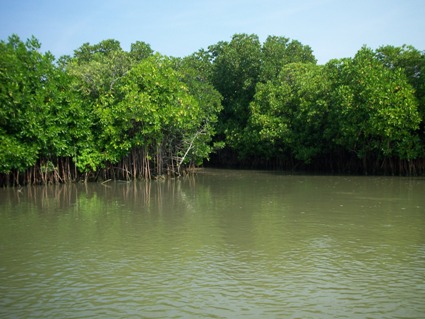The latest report of the Forest Survey of India (FSI), 2015 released in December has recorded a net increase of 112 sq. km. of mangroves forest — one of the regions most vulnerable to climate change.
 The earlier FSI report in 2013 recorded a net decrease of 34 sq. km. of mangrove forest. According to the latest report, the overall mangrove cover in the country stands at 4,740 sq. km., which is 0.14 sq. km. of India’s overall geographical area.
The earlier FSI report in 2013 recorded a net decrease of 34 sq. km. of mangrove forest. According to the latest report, the overall mangrove cover in the country stands at 4,740 sq. km., which is 0.14 sq. km. of India’s overall geographical area.
In fact, there are only 12 States and Union Territories along the country’s coastline that can boast of mangroves.
West Bengal, which has a total mangrove cover of 2,106 sq. km., accounts for 44.5 per cent, the highest in the country. It is followed by Gujarat with about 1,107 sq. km.
Andaman and Nicobar islands also has a considerable mangrove forest cover with 617 sq. km. of it.
As per the report, the very dense mangrove forest in the country comprises 1,472 sq. km. (31.05 per cent), moderately dense mangrove spans 1,391 sq. km (29.75 per cent) and open mangroves constitute 1,877 sq. km. (39.60 per cent).
Numerous studies have shown that mangroves absorb the highest amount of carbon in the nature, including soil carbon.
Mangroves are crucial to the survival of the coastal ecosystem, which is very vulnerable to climate change.
West Bengal, which can considerably increase its mangrove cover, has only been able to augment it by 9 sq. km.
The highest increase in the mangrove cover as per the FSI 2015 is from Maharashtra, which has added 36 sq. km.
Mangroves are buffers between the land and the sea. Coastlines throughout the world are facing serious problems of coastal erosion and threat of rising sea levels due to global warming have increased the threats by several folds.
To control such assault of the sea on land the nature has provided what is called as Mangroves, a tropical littoral ecosystem which is more dynamic than the sea itself.
Importance of Mangroves:
1. Buffer Zone between the land and sea.
2. Protect the land from erosion.
3. Play an invaluable role as nature’s shield against cyclones, ecological disasters and as protector of shorelines.
4. Breeding and nursery grounds for a variety of marine animals.
5. Harbour a variety of lifeforms like invertebrates, fish, amphibians, reptiles, birds and even mammals like tigers.
6. Good source of timber, fuel and fodder.
7. Main source of income generation for shoreline communities like fisherfolk.
8. Save the marine diversity, which is fast diminishing.
9. Purify the water by absorbing impurities and harmful heavy metals and help us to breathe a clean air by absorbing pollutants in the air.
10. Potential source for recreation and tourism.


